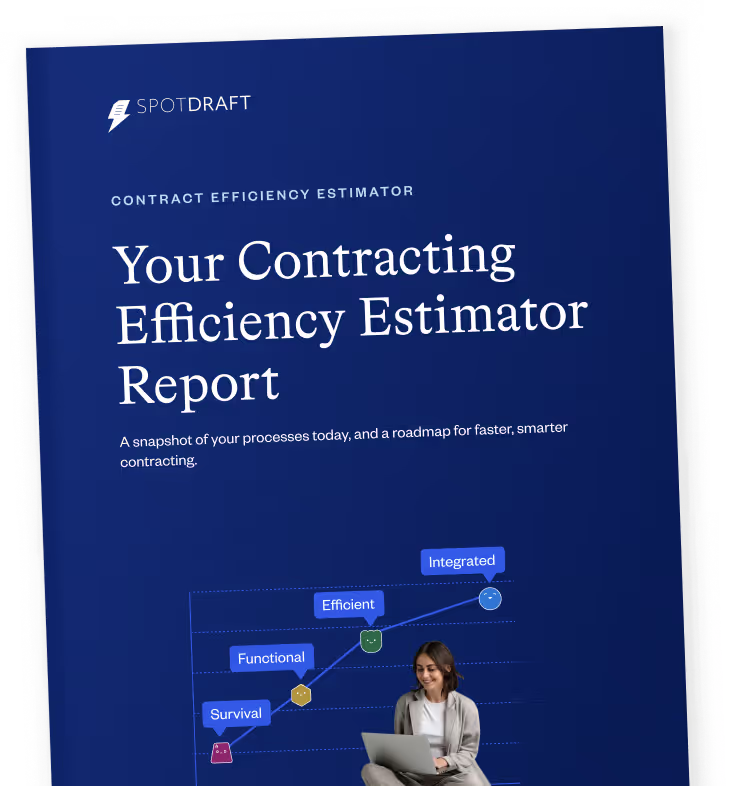TLDR
- 2025 is a pivotal year for legal tech in SaaS, with AI, automation, and platform consolidation reshaping legal operations
- Contract lifecycle management platforms are central to helping legal teams scale and align with business goals
- Key trends include AI-native tools, self-serve workflows, data-driven decision-making, centralized CLM platforms, built-in security, and cross-functional collaboration
- Legal Ops plays a critical role in driving tech adoption and ensuring ROI
There is no slowing down in the SaaS world. The race for market share, faster deals, and customer retention is only accelerating. Legal teams, once seen as bottlenecks, are now expected to keep pace with this velocity. Yet they are often asked to do so with limited headcount and increasing workloads.
This is where legal tech is stepping in to change the game. In 2025, AI-powered automation, smarter contract lifecycle management, and platform consolidation are helping legal teams scale their impact. The shift is not just about adding new tools, but about transforming legal from a reactive function into a strategic enabler.
Contract lifecycle management is at the forefront of this change. Platforms like SpotDraft for SaaS are helping legal teams accelerate deal cycles, enable business self-service, and gain real-time visibility across contracts.
In this blog, we explore six trends shaping legal tech in SaaS this year and how your team can build the right stack for the future.
Why 2025 Is a Turning Point for Legal Tech in SaaS
The legal tech buying process is evolving. No longer driven only by IT, legal teams themselves are now in charge of evaluating and adopting the right platforms. This reflects the increasing alignment between legal and business goals in modern SaaS companies.
To support rapid sales cycles and global expansion, legal must become more agile and scalable. Real-time responsiveness and seamless cross-functional collaboration are critical. The right legal tech stack, particularly in contract lifecycle management, is the key to enabling this shift.
Legal Tech Trends to Watch in 2025

AI-Native Tools for Contracting
AI is now built into the DNA of legal tech platforms. From automated contract review to clause extraction and risk analysis, AI helps legal teams reduce time spent on repetitive tasks.
By embedding AI directly into the contract lifecycle management process, platforms like SpotDraft for SaaS give legal teams greater efficiency without sacrificing control. The focus for 2025 will be on selecting tools that offer transparency and reliability, ensuring that AI outputs can be trusted for business-critical decisions.
Self-Serve Legal Workflows
Leading SaaS legal teams are designing self-service workflows that empower business users to initiate and manage contracts. Smart templates, conditional logic, and guided intake forms reduce legal’s workload while ensuring compliance.
As shown in SpotDraft’s CLM Checklist, this trend leads to faster deal cycles, fewer escalations, and improved user experience across the company.
Data-Driven Decision-Making
Legal ops teams are increasingly using data to drive decisions. Dashboards now track turnaround times, risk flags, and contract values. Predictive insights inform negotiation strategies and resourcing.
A modern contract lifecycle management platform gives SaaS legal teams the ability to continuously improve their processes and measure their contribution to business outcomes.
Centralized Contract Lifecycle Management Platforms
SaaS companies are moving away from fragmented legal tools toward centralized contract lifecycle management platforms. Integration with CRM, billing, procurement, and communication tools reduces context-switching and improves visibility.
According to SpotDraft’s Counsel Corner, centralization also helps legal teams scale their efforts and deliver more strategic value.
Focus on Security and Compliance by Design
Built-in security and compliance features are now standard in modern legal tech platforms. Audit trails, role-based access, and automated compliance checks are especially critical in sectors like fintech, edtech, and healthtech.
Choosing platforms with these capabilities ensures that risk management scales alongside the business.
Cross-Functional Collaboration Built In
Cross-functional collaboration is being embedded into the design of contract lifecycle management platforms. Shared dashboards, real-time notifications, approval workflows, and redline visibility promote alignment between legal, sales, finance, and customer success.
By breaking down silos, legal tech is helping SaaS companies accelerate contract execution and drive revenue faster.
The Role of Legal Ops in Tech Evaluation
Legal operations teams are leading the charge in legal tech transformation. Acting as the bridge between tools and execution, Legal Ops ensures that technology delivers measurable outcomes.
Focusing on metrics like ROI, user adoption, and efficiency gains, Legal Ops plays a key role in selecting platforms that align with business needs and drive continuous improvement.
Choosing the Right Legal Tech Stack in 2025
When evaluating legal tech platforms in 2025, SaaS legal teams should ask:
- Does this integrate with our systems?
- Can it manage our contract lifecycle management end-to-end?
- Is it scalable and secure?
Prioritize solutions that address your biggest gaps, whether intake, contract review, or post-signature visibility. Building the right foundation now will future-proof your legal tech stack.
Conclusion
2025 is the year legal tech becomes business as usual. Legal teams that embrace modern platforms, especially in contract lifecycle management, will be best positioned to scale with their SaaS businesses.
Stay informed, invest in the right tools, and keep evolving your legal stack to meet the demands of tomorrow’s SaaS landscape.
FAQs:
1. Why is 2025 considered a turning point for legal tech in SaaS?
Legal and business goals are now more aligned, and legal teams are driving tech adoption to support faster deal cycles, scalability, and improved collaboration.
2. What role does contract lifecycle management play in modern SaaS legal teams?
Contract lifecycle management helps legal teams accelerate contract review, enable business self-service, improve visibility, and scale their impact across the company.
3. What should SaaS legal teams consider when selecting a legal tech stack?
Teams should focus on integration, end-to-end contract lifecycle management capabilities, scalability, and built-in security to future-proof their legal tech investments.

.avif)
.avif)



.avif)



